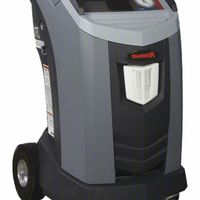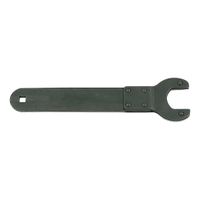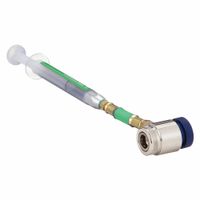Call +(254) 703 030 000 / 751 483 999 / 721 704 777
- Home
- Fleet Vehicle Maintenance
- Vehicle Tools
- Vehicle Heating Cooling Tools
Vehicle Heating & Cooling Tools
AC refrigerant machines and accessories support the maintenance and repair of vehicle air conditioning systems and enhance their performance. Fan clutch tools remove fan clutch assemblies on engines. Service and repair tools help repair issues in vehicle cooling and heating systems. Read Less
Frequently Asked Questions
What is the best refrigerant for my vehicle's AC system?
The best refrigerant for your vehicle's AC system largely depends on the make, model, and year of your vehicle, as well as environmental regulations and efficiency considerations.
For most modern vehicles, R-134a is the standard refrigerant. It has been widely used since the early 1990s due to its relatively low environmental impact compared to its predecessor, R-12, which was phased out due to its ozone-depleting properties. R-134a is efficient, widely available, and compatible with most vehicle AC systems designed in the last few decades.
However, due to growing environmental concerns, R-134a is being gradually replaced by R-1234yf in newer vehicles. R-1234yf has a much lower global warming potential (GWP) than R-134a, making it a more environmentally friendly option. Many manufacturers have started using R-1234yf in compliance with international regulations aimed at reducing greenhouse gas emissions.
If your vehicle was manufactured before the 1990s and still uses R-12, it is advisable to retrofit the system to use R-134a or R-1234yf, as R-12 is no longer produced and is harmful to the environment.
When choosing a refrigerant, consider the following:
1. **Compatibility**: Ensure the refrigerant is compatible with your vehicle's AC system.
2. **Environmental Impact**: Opt for refrigerants with lower GWP.
3. **Availability and Cost**: Consider the availability and cost of the refrigerant and any necessary retrofitting.
Consult your vehicle's manual or a professional mechanic to determine the most suitable refrigerant for your specific vehicle.
How do I know if my AC system needs a recharge?
To determine if your AC system needs a recharge, look for the following signs:
1. **Reduced Cooling Efficiency**: If your AC is blowing warm or less cool air than usual, it might indicate low refrigerant levels.
2. **Longer Cooling Cycles**: If the AC takes longer to cool your space or runs continuously without reaching the desired temperature, it may need a recharge.
3. **Ice Formation**: Ice on the refrigerant lines or evaporator coil can signal low refrigerant levels, as the system struggles to absorb heat.
4. **Hissing or Bubbling Noises**: These sounds can indicate a refrigerant leak, which would necessitate a recharge after the leak is repaired.
5. **Visible Refrigerant Leaks**: Oily residue or stains around the AC unit can suggest a refrigerant leak, leading to low levels.
6. **Higher Energy Bills**: If your energy bills have increased without a change in usage, the AC might be working harder due to low refrigerant.
7. **AC System Age**: Older systems may require more frequent recharges due to wear and tear.
8. **Professional Inspection**: Regular maintenance checks by a professional can identify low refrigerant levels and other issues.
If you notice these signs, it's advisable to contact a professional HVAC technician to inspect and recharge your AC system, as handling refrigerants requires specialized knowledge and equipment.
What tools are needed to remove a fan clutch assembly?
To remove a fan clutch assembly, you will typically need the following tools:
1. **Fan Clutch Wrench Set**: This specialized set includes a fan clutch holding tool and a fan clutch wrench. The holding tool is used to keep the water pump pulley in place, while the wrench is used to turn the large nut on the fan clutch.
2. **Adjustable Wrench or Spanner**: In some cases, an adjustable wrench or a specific size spanner may be required to fit the fan clutch nut.
3. **Socket Set**: A socket set with a ratchet may be necessary to remove any bolts or nuts securing the fan shroud or other components that obstruct access to the fan clutch.
4. **Screwdrivers**: Both flathead and Phillips screwdrivers might be needed to remove any clips or screws holding the fan shroud or other components.
5. **Pry Bar**: A pry bar can be useful for gently prying off the fan clutch if it is stuck or difficult to remove.
6. **Penetrating Oil**: Applying penetrating oil can help loosen any rusted or stubborn nuts and bolts.
7. **Torque Wrench**: A torque wrench may be needed to ensure that any bolts or nuts are tightened to the manufacturer's specifications during reassembly.
8. **Safety Gear**: Safety glasses and gloves should be worn to protect against debris and sharp edges.
9. **Service Manual**: A vehicle-specific service manual can provide detailed instructions and specifications for removing and installing the fan clutch assembly.
These tools will help you safely and effectively remove a fan clutch assembly from most vehicles.
How can I improve the performance of my vehicle's air conditioning system?
To enhance your vehicle's air conditioning (AC) performance, start with regular maintenance. Replace the cabin air filter every 12,000 to 15,000 miles or as recommended by the manufacturer to ensure optimal airflow. Check the refrigerant level; low refrigerant can reduce cooling efficiency. If necessary, recharge the system with the correct type of refrigerant.
Inspect the AC compressor belt for wear and tension. A loose or worn belt can hinder the compressor's performance. Clean the condenser, located in front of the radiator, to remove debris and dirt that can obstruct airflow and reduce cooling efficiency.
Ensure the evaporator and condenser coils are clean. Use a coil cleaner or a soft brush to remove dust and grime. Check for leaks in the AC system, as leaks can lead to refrigerant loss and decreased performance. Use a UV dye or electronic leak detector to identify leaks.
Optimize airflow by ensuring that all vents are open and unobstructed. Use the recirculation mode to cool the cabin faster, as it recycles the already cooled air. Park in shaded areas or use sunshades to reduce the cabin temperature before starting the AC.
Consider installing window tinting to reduce heat gain. Regularly run the AC, even in winter, to maintain the system's lubrication and prevent seals from drying out. If the AC system is old or consistently underperforming, consult a professional mechanic to assess the need for component replacement or upgrades.
Finally, ensure the vehicle's cooling system is functioning properly, as an overheating engine can affect AC performance. Regularly check coolant levels and inspect the radiator and hoses for leaks or damage.
What are the signs of a failing AC compressor?
Signs of a failing AC compressor include:
1. **Reduced Cooling Efficiency**: The AC system may blow warm air or take longer to cool the space, indicating the compressor is struggling to circulate refrigerant.
2. **Unusual Noises**: Grinding, squealing, or rattling noises from the outdoor unit can signal mechanical issues within the compressor.
3. **Frequent Circuit Breaker Trips**: A failing compressor may draw excessive power, causing the circuit breaker to trip repeatedly.
4. **Hard Starting**: Difficulty in starting the AC unit or frequent stalling can indicate compressor problems.
5. **Vibrations or Shaking**: Excessive vibrations or shaking of the outdoor unit can be a sign of compressor failure.
6. **Refrigerant Leaks**: Oil or refrigerant leaks around the compressor or connections can indicate internal damage.
7. **High Energy Bills**: A failing compressor may cause the system to work harder, leading to increased energy consumption.
8. **Burning Smell**: A burnt or electrical smell from the unit can indicate overheating or electrical issues within the compressor.
9. **Compressor Doesn’t Turn On**: If the compressor doesn’t start despite the fan running, it may be due to electrical or mechanical failure.
10. **Tripped Overload Protector**: The overload protector may trip to prevent damage if the compressor overheats, indicating a problem.
11. **Visible Damage**: Physical damage or corrosion on the compressor can be a sign of impending failure.
12. **Inconsistent Temperatures**: Fluctuating indoor temperatures can result from a malfunctioning compressor.
If these signs are present, it is advisable to consult a professional technician for diagnosis and repair.
How often should I service my vehicle's AC system?
You should service your vehicle's AC system every 1 to 2 years. Regular maintenance ensures optimal performance, prevents costly repairs, and extends the system's lifespan. During a service, a technician will check for leaks, inspect the compressor, clean the condenser, and ensure the refrigerant levels are adequate. If you notice reduced cooling efficiency, unusual noises, or unpleasant odors, it may indicate the need for immediate servicing. Additionally, if you live in a region with extreme temperatures or use the AC frequently, more frequent checks might be necessary. Regular servicing helps maintain air quality, improves fuel efficiency, and ensures a comfortable driving experience.
What are common issues with vehicle cooling and heating systems?
Common issues with vehicle cooling and heating systems include:
1. **Coolant Leaks**: Leaks can occur in hoses, the radiator, or the water pump, leading to insufficient coolant levels and overheating.
2. **Thermostat Failure**: A malfunctioning thermostat can cause the engine to overheat or not reach optimal operating temperature, affecting both cooling and heating.
3. **Radiator Problems**: Clogs or damage in the radiator can impede coolant flow, leading to overheating. Corrosion can also cause leaks.
4. **Water Pump Issues**: A failing water pump can result in inadequate coolant circulation, causing the engine to overheat.
5. **Heater Core Malfunctions**: A clogged or leaking heater core can lead to insufficient cabin heating and potential coolant loss.
6. **Blower Motor Failures**: A faulty blower motor can prevent air from circulating through the heating and cooling system, affecting cabin temperature control.
7. **Clogged Air Filters**: Dirty or clogged air filters can restrict airflow, reducing the efficiency of both heating and cooling systems.
8. **Faulty Fan**: A malfunctioning cooling fan can lead to overheating, especially in stop-and-go traffic or while idling.
9. **Low Refrigerant Levels**: Inadequate refrigerant in the air conditioning system can result in poor cooling performance.
10. **Electrical Issues**: Faulty wiring or blown fuses can disrupt the operation of the cooling and heating systems.
11. **Control System Failures**: Problems with the climate control system, such as a faulty control panel or sensors, can lead to incorrect temperature regulation.
12. **Belt and Hose Wear**: Worn or broken belts and hoses can lead to system failures, including overheating and loss of heating capability.
Regular maintenance and timely repairs are essential to prevent these issues and ensure the efficient operation of vehicle cooling and heating systems.


